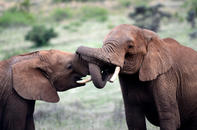Communication
Elephants communicate through body posturing or vocally by use of trumpeting or even screaming to indicate anger or excitement. Trumpeting originates in the larynx and is resonated in the trunk. Most communication takes place through rumbling also produced by the vocal chords and possibly amplified in the upper regions of the trunk.

Some of the rumbles (that sound like tummy-rumbles) are audible to humans but some are infrasonic messages that occur at low wavelengths and are inaudible. These infrasonic sounds can be detected by other elephants twelve kilometres away and helps to coordinate movements between animals out of eyeshot and even normal earshot of one another.
It is suspected that elephants detect these ‘vibrations’ through their feet. Both bull and cow elephant have temporal glands on the sides of their foreheads. While bulls secrete from these profusely during musth, cows and youngsters also secrete from these glands when under stress. Elephants may collect chemical clues from one another during greeting ceremonies that involve the scenting of these glands with the end of the trunk.
Elephant Graveyard

The concept of an elephant graveyard is much disputed. One explanation may be that elephants on their last set of molars spend lots of time at water where the food is softer and if they can’t eat then at least they can drink. Several old elephants may then die at the same waterhole if it is the only available water in an area giving the impression of a graveyard.
Elephants are believed to grieve their dead as they movingly pick up tusks, skulls and bones of dead elephants carrying them around or scenting them with their trunks. Elephants will also go to the aid of sick or wounded members of the herd.
By Megan Emmett